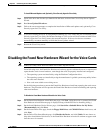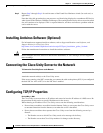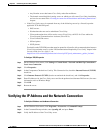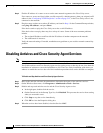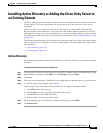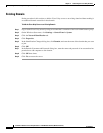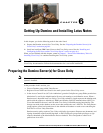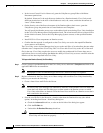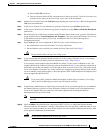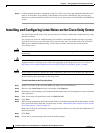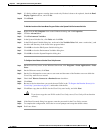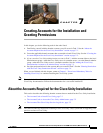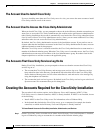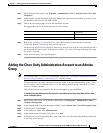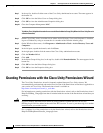
6-3
Installation Guide for Cisco Unity Release 5.x with IBM Lotus Domino (Without Failover)
OL-13599-01
Chapter 6 Setting Up Domino and Installing Lotus Notes
Preparing the Domino Server(s) for Cisco Unity
d. Check the In File check box.
e. Choose a location for the ID file, and make note of where you saved it. You will use it when you
configure Lotus Notes on the Cisco
Unity server, later in the installation.
Step 3 Add the Cisco Unity Person to the UnityServers group that you created in Step 1. Refer to the applicable
IBM Lotus documentation.
Step 4 In the Access Control List for Admin4.nsf, grant the UnityServers group Editor permissions.
Step 5 In the Access Control List for Names.nsf, grant the UnityServers group Editor with Delete Documents
permissions.
Step 6 On the Security tab of the Server document of the Domino address book server, grant the UnityServers
group the permission to Create Databases and Templates. (You will specify the Domino server to use
as the address book server during Cisco
Unity installation in the Cisco Unity Message Store
Configuration wizard.)
Step 7 Install csServer, the server component of DUC for Cisco, on the following servers:
• On each Domino server that will home Cisco Unity subscribers.
• On the Domino server on which you created the Lotus Notes mail file in Step 2.
Caution Do not install csServer on the Cisco Unity server.
Step 8 If you selected the mail template MailX.ntf (where X is the version of Domino in use—for example,
Mail6.ntf for Domino 6.0) during csServer installation in
Step 7, skip to Step 9.
If you selected a mail template other than MailX.ntf (where X is the version of Domino in use—for
example, Mail6.ntf for Domino 6.0) during csServer installation in
Step 7, rerun csServer installation on
the Domino server that you intend to use as the address book server for Cisco Unity. (The address book
server is the Domino server that Cisco
Unity monitors for changes to the primary address book, and the
server on which it creates default objects.) Select the option to DUC-enable multiple mail templates, then
select the applicable MailX.ntf file.
Caution If you do not DUC-enable the MailX.ntf template, default objects created by Cisco Unity,
such as the Unity Messaging account, may not function correctly.
Step 9 In the Domino Administrator or Lotus Notes client on the server you would typically use to administer
the Domino Directory, switch to a Notes
ID that has Designer or higher access to the administration
server for the Domino Directory, then close all windows applications including the Domino
Administrator and Lotus Notes client.
Note The switch is required for the next step. After you begin the step, you cannot switch to another
Notes ID.
Step 10 Install csAdmin, the administration component of DUC for Cisco, to update the Domino domain
directory database. The database is usually called Names.nsf, but it may have a different name on your
system. You install csAdmin only once for the domain. For more detailed installation instructions, refer
to the applicable IBM Lotus documentation.
Caution Do not install csAdmin on the Cisco Unity server.



